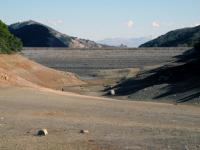-
As the climate warms, New Jersey “primed” for worse storms than Sandy
With the climate warming and the sea level rising, conditions are ripe for storms deadlier and more devastating than Sandy that put more people at risk. Experts say that Sandy was not the worst possible storm in the region and they warn that as the sea rises, much weaker storms than Sandy may pack big punches. The atmosphere will hold nearly 4 percent more moisture for every 1 degree Fahrenheit rise in temperature, and the increased warmth and moisture will lead to a more energetic atmosphere.
-
-
A military view on climate change: It’s eroding our national security and we should prepare for it
U.S. military leaders and defense planners have been studying climate change for years from a perspective that rarely is mentioned in the news: as a national security threat. And they agree that it poses serious risks. Here is how military planners see this issue: We know that the climate is changing, we know why it’s changing, and we understand that change will have large impacts on our national security. Yet as a nation we still only begrudgingly take precautions. The next president will have a choice to make. One option is to continue down the path that the Obama administration has defined and develop policies, budgets, plans, and programs that flesh out the institutional framework now in place. Alternatively, he or she can call climate change a hoax manufactured by foreign governments and ignore the flashing red lights of increasing risk. The world’s ice caps will not care who is elected or what is said. They will simply continue to melt, as dictated by laws of physics. But Americans will care deeply about our policy response. Our nation’s security is at stake.
-
-
New $4 million facility at UW to investigate natural disasters worldwide
A new Post-Disaster, Rapid Response Research Facility at the University of Washington will provide necessary instrumentation and tools to collect and assess critical post-disaster data, with the goal of reducing physical damage and socio-economic losses from future events. The NSF’s $40 million NHERI investment, announced in September 2015, funds a network of shared research centers and resources at various universities across the nation. The goal is to reduce the vulnerability of buildings, tunnels, waterways, communication networks, energy systems, and social groups in order to increase the disaster resilience of communities across the United States.
-
-
DHS S&T announces 10 start-ups for first responder technology innovation
DHS S&T has announced the selection of ten startup companies to be part of EMERGE 2016: Wearable Technology, a program designed to bring startups, accelerators, and other strategic partners together in a common research and development effort. The program is focused on wearable technology that can be modified specifically for first responders.
-
-
Megadrought lasting three decades likely for Southwest U.S., Midwest

The consequences of climate change paint a bleak picture for the Southwest and much of America’s breadbasket, the Great Plains. The role of climate change in causing extreme heat waves, drastic rainfall, negative impacts on human health, and threatened food security have received more attention recently than megadrought, but scientists view prolonged drought risk as yet another natural hazard that becomes more likely from human activity.
-
-
Relentless rise of CO2 passes troubling milestone, locking in a warmer future
Carbon dioxide levels in Earth’s atmosphere passed a troubling milestone for good this summer and locked in levels of the heat-trapping gas not seen for millions of years. Every year, the amount of carbon dioxide (CO2) rises during winter and then falls slightly during the Northern Hemisphere’s growing season, as plants take up the greenhouse gas during photosynthesis. But this year, for the first time since before the Ice Age, CO2 will not fall below 400 ppm.
-
-
Half of U.S. business R&D concentrated in five states
Five states accounted for just over half of the $255 billion of research and development (R&D) companies paid for and performed in the United States in 2013. The five states with the highest levels of business R&D performance — California, Massachusetts, Michigan, Texas, and Washington — accounted for $133 billion, or 52 percent, of the total.
-
-
S&T selects RAND Corp. to operate new DHS research center

DHS has selected the RAND Corporation to operate the Homeland Security Operational Analysis Center (HSOAC), which will conduct technical and operational research and analysis to aid the department. The new center is a federally funded research and development center, and is funded under a five-year contract worth as much as $494.7 million.
-
-
Global warming could hit 2°C threshold by 2050
Without additional action and advanced technologies, global emissions are expected to be 33 percent above the 2°C pathway in 2030, according to a new report. The 2°C target was formally agreed upon at the Paris climate talks in 2015, as an international target to avoid the worst effects of climate change.
-
-
Slowing the spread of infectious diseases
Outbreaks of infectious diseases such as Zika increasingly threaten global public health. Scientists expect five such new diseases to emerge each year. To find out whether our interaction with the environment is somehow responsible, the Ecology and Evolution of Infectious Diseases (EEID) program — a joint effort of the National Science Foundation (NSF), National Institutes of Health (NIH), and the U.S. Department of Agriculture (USDA) — has awarded $16.6 million in new grants. The scientists receiving the grants will study disease transmission among humans, other animals, and environment.
-
-
Game theory research highlights fragility of common resources
New research in game theory shows that people are naturally predisposed to over-use “common-pool resources” such as transportation systems and fisheries even if it risks failure of the system, to the detriment of society as a whole. The research could have implications for the management of engineered systems such as the power grid, communications systems, distribution systems, and online file sharing systems, along with natural systems such as fisheries.
-
-
Optimal strategies to cope with climate change depend on the pace of change
What would we do differently if sea level were to rise one foot per century versus one foot per decade? Until now, most policy and research has focused on adapting to specific amounts of climate change and not on how fast that climate change might happen. Researchers, using sea-level rise as a case study, have developed a quantitative model that considers different rates of sea-level rise, in addition to economic factors, and shows how consideration of rates of change affect optimal adaptation strategies.
-
-
DHS awards U Texas San Antonio $3 million to develop, deliver cybersecurity training
The Department of Homeland Security (DHS) has selected a team led by the University of Texas at San Antonio (UTSA) to develop and deliver cybersecurity training through the Continuing Training Grants (CTG) Program. The 2016 CTG is a $3 million grant to develop and deliver cybersecurity training to support the national preparedness goal to make the United States more secure and resilient.
-
-
Recent history of U.S. floods shows regional trends, but no national pattern
A new study examined the recent history of floods in the United States for the time period 1940-2013. The scientists found some regional trends, but no widespread national pattern of flood change. “An important prerequisite for effective flood risk management is to have an accurate assessment of how flooding is changing over time,” said one researcher. “Of course, changes in climate as well as land- and water-use management are each potential sources of change in flooding frequency or magnitude. But the relative influence of these factors across broad areas has been difficult to discern.”
-
-
California's almond boom ramped up water use, consumed wetlands
Converting land in California to grow water-hungry almonds between 2007 and 2014 has led to a 27 percent annual increase in irrigation demands — despite the state’s historic drought. The expansion of almonds has also consumed 16,000 acres of wetlands and will likely put additional pressure on already stressed honeybee populations.
-
More headlines
The long view
New Technology is Keeping the Skies Safe
DHS S&T Baggage, Cargo, and People Screening (BCP) Program develops state-of-the-art screening solutions to help secure airspace, communities, and borders
Factories First: Winning the Drone War Before It Starts
Wars are won by factories before they are won on the battlefield,Martin C. Feldmann writes, noting that the United States lacks the manufacturing depth for the coming drone age. Rectifying this situation “will take far more than procurement tweaks,” Feldmann writes. “It demands a national-level, wartime-scale industrial mobilization.”
How Artificial General Intelligence Could Affect the Rise and Fall of Nations
Visions for potential AGI futures: A new report from RAND aims to stimulate thinking among policymakers about possible impacts of the development of artificial general intelligence (AGI) on geopolitics and the world order.
Smaller Nuclear Reactors Spark Renewed Interest in a Once-Shunned Energy Source
In the past two years, half the states have taken action to promote nuclear power, from creating nuclear task forces to integrating nuclear into long-term energy plans.
Keeping the Lights on with Nuclear Waste: Radiochemistry Transforms Nuclear Waste into Strategic Materials
How UNLV radiochemistry is pioneering the future of energy in the Southwest by salvaging strategic materials from nuclear dumps –and making it safe.
Model Predicts Long-Term Effects of Nuclear Waste on Underground Disposal Systems
The simulations matched results from an underground lab experiment in Switzerland, suggesting modeling could be used to validate the safety of nuclear disposal sites.
